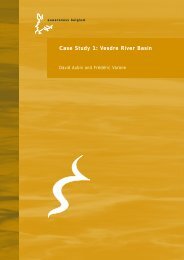Case Study 1: Matarraña River Basin - Euwareness
Case Study 1: Matarraña River Basin - Euwareness
Case Study 1: Matarraña River Basin - Euwareness
Create successful ePaper yourself
Turn your PDF publications into a flip-book with our unique Google optimized e-Paper software.
Use rights and practices<br />
Some uses of water in the <strong>Matarraña</strong> river basin date from centuries and they are<br />
mostly related to irrigation. Most of the irrigation channels still working today were built<br />
by the Arabic population who settled down in the Peninsula, and the most antique<br />
irrigation communities existing today date back to the early XIXth century. Nowadays,<br />
there are 39 irrigation communities located in 10 municipalities along the <strong>Matarraña</strong><br />
river basin, each of them having their own irrigation channels and their own water<br />
concessions. Concessions for using water were given along the XIXth and XXth<br />
century, and users understand they have them in perpetuity. Plots (peace of land) are<br />
ascribed to irrigation channels and by this they have their use rights to irrigate.<br />
Irrigation communities have their own statutes and rules of functioning, and it is them<br />
those deciding how to distribute water taken directly from the river. The 39 irrigation<br />
communities are represented at the Central Union, which is the institution deciding on<br />
how to distribute water coming from the Pena dam along the river basin.<br />
As it has already been mentioned, nowadays water for irrigation in the <strong>Matarraña</strong> river<br />
basin can be taken either from the river or from the Pena dam. Water can be taken<br />
from any of the two sources in order to cover different type of uses.<br />
Regarding population supply, water is taken both from the river and from the Pena<br />
dam. In Valderrobres, it is also taken from a well opened recently, and in the lower<br />
basin (Fabara and Nonaspe), water for population supply is also taken from the<br />
Ribarroja dam in the Ebro river in cases of extreme scarcity. Each municipality has a<br />
concession of water for population supply in perpetuity (although some animal farms in<br />
some municipalities are also connected to the municipal water network). The prize of<br />
water is fixed by each municipality. Given the water scarcity problems, a rivalry<br />
between use of water for population supply and agriculture often emerges. To this<br />
respect, the Central Union considers that municipalities consume too much water and<br />
has asked the CHE to fix gauging stations in the municipalities in order to know the<br />
amount of water consumed in each of them.<br />
Regarding irrigation, water is also taken both directly from the river and from the Pena<br />
dam. In case it is taken directly from the river, the concessions given to the irrigation<br />
communities by the CHE have a maximum quantity of water (litres/second/Ha), as far<br />
as the river has water enough to cover needs in all the river basin). It is irrigation<br />
communities those deciding how to distribute water among users. It must be taken into<br />
24



